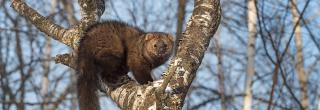
Fisher
Fact Sheet | |
|---|---|
Scientific Name | Pekania pennanti |
Description | Fishers are large members of the weasel family, have a weasel-like physique with a long body, short legs, long bushy tail, pointed nose, and short round ears. Their long fur ranges from brown to nearly black and they often have lighter-colored fur around the face and neck. |
Tracks | Front/Rear– 2" L, 2-1/2" W Walking stride: 7" - 11-1/2" |
Total Length | 35-47 inches |
Weight | 5-12 pounds |
Habitat | Fishers prefer forested habitats and in North Dakota are found primarily along wooded riparian streams in the eastern third of the state. Fishers spend most of their time on the ground, but are adept at climbing trees and are known to den in hollow trees and logs. |
Breeding Season | March-May. Fertilized egg then delays implantation for 10-11 months. |
Gestation Period | 30 days |
Litter Size | 1-6 (average 3) |
Social Aspects | Solitary, except when breeding or rearing young. |
Status | Fishers are primarily distributed in the eastern third of the state, but may be found elsewhere. There is a limited trapping season. |
Food Habits | Fishers are carnivorous and prey on small- to medium-sized mammals, including rabbits, squirrels, mice, voles and shrews. They also eat birds and carrion. Fishers are one of the few effective predators of porcupines. |
Fun Facts | Unlike their common name suggests, fishers do not commonly eat fish nor do they live in water. Additionally, female fishers mate soon after they give birth to a litter, after which the fertilized egg will delay implantation until 30 days before giving birth the following year. Therefore, female fishers are in a constant state of pregnancy. |

